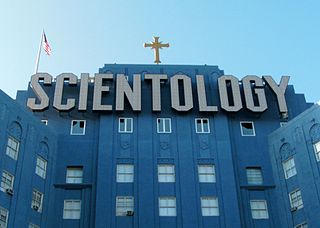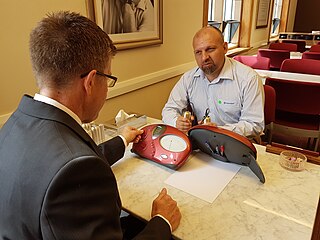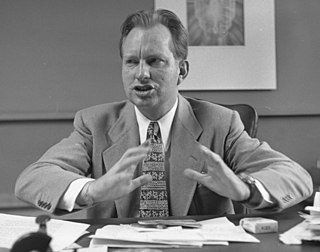
Dianetics is a set of ideas and practices invented in 1950 by science fiction writer L. Ron Hubbard regarding the human mind. Dianetics was originally conceived as a form of psychological treatment, but was rejected by the psychological and medical establishments as pseudoscientific. Dianetics was the precursor to Scientology and has since been incorporated into it.

The Church of Scientology maintains a wide variety of beliefs and practices. The core belief holds that a human is an immortal, spiritual being (thetan) that is resident in a physical body. The thetan has had innumerable past lives, some of which, preceding the thetan's arrival on Earth, were lived in extraterrestrial cultures. Based on case studies at advanced levels, it is predicted that any Scientologist undergoing auditing will eventually come across and recount a common series of past-life events.

In Scientology, the concept of the thetan is similar to the concept of self, or the spirit or soul as found in several belief systems. The term is derived from the Greek letter Θ, theta, which in Scientology beliefs represents "the source of life, or life itself." In Scientology it is believed that it is the thetan, not the central nervous system, which commands the body.

A body thetan or BT is a concept in Scientology of a disembodied thetan (being) that is stuck in, on, or near a human body. All human bodies are said to be infested by these disembodied thetans, or clusters of them.

In Scientology, Operating Thetan (OT) is a state of complete spiritual freedom in which one is a "willing and knowing cause over life, thought, matter, energy, space and time". The Church of Scientology offers eight "levels" of OT, each level costing thousands of US dollars. The OT levels are confidential and not revealed to Scientologists until they reach the third Operating Thetan level. In practice, the objective of these levels is to remove "body thetans" which are "confused, disembodied souls from other planets who have attached themselves to us".

Auditing, also known as processing, is the core practice of Scientology. Scientologists believe that the role of auditing is to improve a person's abilities and to reduce or eliminate their neuroses. The Scientologist is asked questions about past events while holding two tin cans attached to an electrical resistance meter (galvanometer) with a dial. The term "auditing" was coined by L. Ron Hubbard in his 1950 book Dianetics: The Modern Science of Mental Health which describes the process. Auditing uses techniques from hypnosis that are intended to create dependency and obedience in the subject.

Dianetics: The Modern Science of Mental Health, sometimes abbreviated as DMSMH, is a book by L. Ron Hubbard about Dianetics, a pseudoscientific system that he claimed to have developed from a combination of personal experience, basic principles of Eastern philosophy and the work of Sigmund Freud. The book is considered part of Scientology's canon. It is colloquially referred to by Scientologists as Book One. The book launched the movement, which later defined itself as a religion, in 1950. As of 2013, New Era Publications, the international publishing company of Hubbard's works, sells the book in English and in 50 other languages.

Scientology and its perspectives on sexual orientation are based on the writings of L. Ron Hubbard, the founder of the Church of Scientology. His statements about homosexuality have led critics to assert that Scientology promotes homophobia, though these allegations are disputed by some Scientologists.

Scientology founder L. Ron Hubbard explicitly compared his teachings to the science-fiction subgenre space opera. In his writings, wherein thetans were reincarnated periodically over quadrillions of years, retaining memories of prior lives, to which Hubbard attributed complex narratives about life throughout the universe. The most controversial of these myths is the story of Xenu, to whom Hubbard attributed responsibility for many of the world's problems.
In Dianetics and Scientology, Clear is a status afforded to followers by the Scientology organization, or by other Scientologists, after they complete certain activities. It is one of the major ostensible "states" practitioners strive to reach on their way up what the Scientologists call the Bridge to Total Freedom. Scientology followers are given the status of Clear when a person is deemed to be free of the influence of engrams – supposed unwanted emotions or painful traumas which Scientology claims are not readily available to the conscious mind. Scientologists believe that human beings accumulate anxieties, psychosomatic illnesses, and aberration due to receiving engrams throughout their current or past lives, and that by applying Dianetics, every single person can obtain the status of Clear.

MEST is an acronym for matter, energy, space and time, and means the physical universe. It was coined in 1950 by Scientology founder L. Ron Hubbard, and is spoken as a word rather than spelling out the letters.

An engram, as used in Dianetics and Scientology, is a detailed mental image or memory of a traumatic event from the past that occurred when an individual was partially or fully unconscious. It is considered to be pseudoscientific and is different from the meaning of "engram" in cognitive psychology. According to Dianetics and Scientology, from conception onwards, whenever something painful happens while the "analytic mind" is unconscious, engrams are supposedly being recorded and stored in an area of the mind Scientology calls the "reactive mind".

Silent birth, sometimes known as quiet birth, is a birthing procedure advised by L. Ron Hubbard and advocated by Scientologists in which "everyone attending the birth should refrain from spoken words as much as possible" and where "... chatty doctors and nurses, shouts to 'PUSH, PUSH' and loud or laughing remarks to 'encourage' are avoided". According to Scientology doctrine, this is because "any words spoken are recorded in the reactive mind and can have an aberrative effect on the mother and the child." Hubbard asserted that not maintaining verbal silence during childbirth could adversely affect the child later in life. Church members believe that noises, sounds and words while a child is being born can possibly cause trauma, which in turn causes the production of engrams, thus necessitating silent birth. Scientologists believe that it is also a way to assist a newborn in his or her development spiritually.

Scientology: A History of Man is a book by L. Ron Hubbard, first published in 1952 under the title What to Audit by the Scientific Press of Phoenix. According to the author, it provides "a coldblooded and factual account of your last sixty trillion years." It has gone through many editions since its first publication and is a key text of the Church of Scientology. The book has been ridiculed by critics of Scientology for its unusual writing style and pseudoscientific claims; it has been described as "a slim pretense at scientific method ... blended with a strange amalgam of psychotherapy, mysticism and pure science fiction; mainly the latter."

OT VIII or OT 8 is the highest current auditing level in Scientology. OT VIII is known as "The Truth Revealed" and was first released to select high-ranking public Scientologists in 1988, two years after the death of Scientology's founder, L. Ron Hubbard. OT VIII is only delivered to members of the Church of Scientology in one place—aboard the organization's private cruise ship, the Freewinds, and is additionally available from independent Scientology groups. There are a few advanced auditors that are able to deliver the level to those who meet the prerequisites.

This bibliography of Scientology includes Scientology and Dianetics-related books authored by L. Ron Hubbard and those produced by the Church of Scientology and its related organizations. Books bearing L. Ron Hubbard's name are considered texts of Scientology's canon.
The amount of material on Dianetics and Scientology is extensive, to say the least. This material is composed of books by L. Ron Hubbard ; compilations of his works; taped lectures; auditor training materials ; course packages; booklets; a large number of magazines and annuals; and video recordings of the major annual events.
L. Ron Hubbard used the term incident in a specific context for auditing in Scientology and Dianetics: the description of space operatic events in the Universe's distant past, involving alien interventions in past lives. It is a basic belief of Scientology that a human being is an immortal spiritual being, termed a thetan, trapped on planet Earth in a "meat body".

The relationship between Scientology and religious groups is very complex. While Scientology claims that it is fully compatible with all existing major world religions and that it does not conflict with them or their religious practices, there are significant contradictions between Scientology and most religions, especially the major monotheistic religions. Members are not allowed to engage in other similar mental therapies or procedures, religious or otherwise.

The intersection of Scientology and abortion has a controversial history which began with Scientology founder L. Ron Hubbard's discussion of abortion in his 1950 book Dianetics: The Modern Science of Mental Health. Hubbard wrote in Dianetics that abortion and attempts at abortion could cause trauma to the fetus and to the mother in both spiritual and physical ways. Scientologists came to believe that attempted abortions could cause traumatic experiences felt by the fetus, which would later be remembered as memories referred to in Scientology as "engrams". In the Scientology technique called Auditing, Scientologists are frequently queried regarding their sexual feelings and behaviors. These questions about Scientologists' sexual behavior are often posed to members during "security checks", a specific form of auditing sessions where individuals are required to document their divergence from the organization's ethics. One of the questions asked in these security checks is, "Have you ever been involved in an abortion?".

Scientology has a complex relationship with concepts of gender roles and discrimination, as while the core beliefs of Scientology hold humans to consist of genderless Thetans, the Church and other Scientology organizations have frequently been noted as upholding discriminatory policies or views based on the original writings of founder L. Ron Hubbard.





